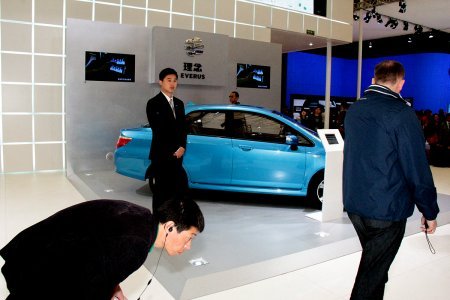Shanghai Motor Show: Repent, The End Of Fake Chinese Brands Is Near

This triggered fears that the laowei would be kicked out in short order, while the Chinese would flood western markets with cheap cars made with expropriated intellectual property. It didn’t work out that way. At the Shanghai Auto Show, new attempts of the Chinese government to gain technology for free have the smell of death.
The foreigners made a killing, while the Chinese are still trying to get a handle on technology. 30 years after the first Western cars were made in China, Chinese car exports are still a non-issue. Meanwhile, sales in China power Western carmakers to new global sales records. GM and Volkswagen, both market leaders in China, make and sell more cars in the Middle Kingdom than at home. GM just announced plans to expand its Chinese capacities to 5 million cars per year by 2016. Volkswagen, which heretofore planned for 4 million units in China by 2016, is most likely drawing up plans to make a few more than GM.
Unhappy that the great leap forward for the acquisition of car know-how did not go according to plan, Chinese planners came up with another scheme: Foreign carmakers were “encouraged” to create what TTAC soon called “fake Chinese brands,” and what the Chinese erroneously call “sub-brands:” Standalone brands owned by the joint venture, selling cars developed by the joint venture for the Chinese market. The official interpretation of the arm-twisting was to provide “lower cost” cars to the Chinese people. Western and Asian carmakers privately wondered how the extra cost of car development, brand building and channel management and the lack of the all-important scale should create lower costs cars.
However, instead of arguing, they supplied the lower cost cars desired by state planners: Cars built on outdated, last generation platforms, badged with brands announced with great fanfare, but with “absent-minded” follow-through, as Zheng Zhilin, research director of LMC Automotive called it vis-a-vis the Shanghai Daily. According to Zheng, most joint-venture China brands are nothing more than “recycling” outdated manufacturing platforms and giving them new logos. Chinese joint venture partners learned nothing more than creating empty PR fluff and amateurish branding, both arts they already had excelled at. State planners at least saw slightly larger market shares by domestic brands, numbers as home-grown as the C-cups on most booth babes on the show floor.
Not surprisingly, sales by joint venture brands are abysmal. “Some joint-venture China brands involve production of only about 10,000 cars each year,” says the Shanghai paper. GM obligingly was first to say “yes, comrade!” and created the Baojun brand. Two years later, annual 2012 sales of Baojun crawled along at 84,467 units, less than 3 percent of GM China’s total sales for the year.
If you are not into numbers, the state of the joint venture brands and their inherent lunacy can easily be visualized at the Shanghai Auto Show: At previous auto shows in Shanghai and Beijing, joint venture brands sported elaborate displays and spacious booths. Now, most of them are shoved into a drab corner. Honda’s Everus brand for instance, launched two years ago, has one bland blue car on an uninspired display, guarded by a bored man, while the rest of the Honda booth rocks and rolls.
In a sign that joint venture brands are a passing fad, Mazda’s joint venture partner Changan will soon launch a car in China that uses technology provided by Mazda, but that does not carry a new fake brand. “It was too costly and would take up too many of our resources for us to start a new brand and develop a dealer network,” Mazda’s CEO Takashi Yamanouchi told Reuters with a candidness other colleagues would not have dared in previous years.
Hopefully, this experience will tell Chinese planners that what China needs is not more, but fewer brands, and not more, but fewer automakers, to create the critical mass needed for meaningful R&D.
Nouvelles connexes


